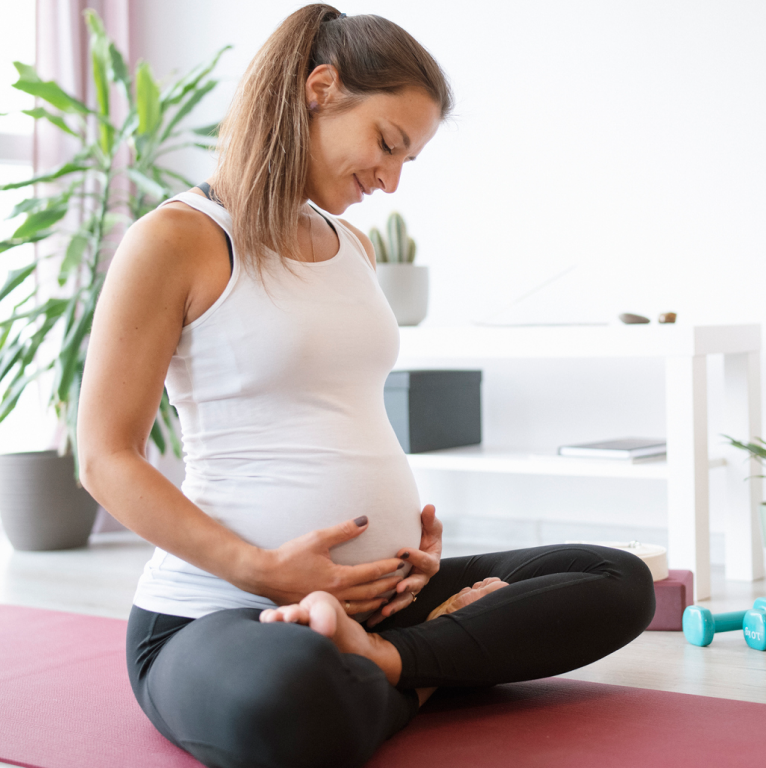When I first got pregnant as a Pilates instructor, I was not sure how to modify my Pilates practice and I ended up with diastasis recti. Instead of learning how to modify properly, I let my ego run the show and did things that were not necessarily smart or beneficial. Ultimately, I paid for my ignorance with a separation of my abdominal muscles.
After learning about my diastasis, I made it my mission to learn everything I could about exercising during pregnancy so that I could prevent other women from making my mistakes. I wanted to be able to guide my clients through a pregnancy that was as healthy and pain-free as possible so I sought out any information on exercise during pregnancy that I could find.
The Fit for Birth PPCES Course was one of the most comprehensive resources available.

As a Pilates instructor, it can be challenging to change the method to suit a pregnant client’s needs. Many Pilates exercises are performed lying on the belly or back, which can be uncomfortable or contraindicated for pregnant women. Additionally, most Pilates certification programs contain little information on how to modify for pregnant clients, yet at some point, most adult women will get pregnant. We owe it to our clients to be knowledgeable about pregnancy and to offer our pregnant participants a safe and effective session.
Through my extensive study of pre and postnatal exercise, I learned that the diastasis recti acquired during pregnancy is often caused by general core dysfunction or even over-tightening the core during pregnancy. This can often be prevented with correct exercise techniques. We, as Pilates instructors, have the ability to empower our clients with these strategies. That leads me to my top 3 tips for training prenatal Pilates clients.
BLOG TOPICS RECOMMENDEd:
Focus on the Breath
Our goal with pregnant women in Pilates is to improve core function to support mom and baby through the many transitions her body will go through. This may seem like an obvious fit for our exercises, but that may not always be true.
For example, hundreds may not be a good fit. Why? Keep reading.
In addition, many Pilates instructors focus mostly on the abdominals and pelvic floor part of the core but forget about the top part of the inner core unit, the diaphragm. You see, Pilates breathing should be diaphragmatic breathing, but instead of breathing into the belly as traditional diaphragmatic breathing, you breathe into the bottom sides of the rib cage and keep the transverse abs pulled in. This can be very difficult for participants to do, let alone pregnant participants. Thus, often times there is a compensation pattern: the diaphragm turns off so that the abs can stay pulled in. Over time, this can lead to a weakening of the diaphragm and an over-tightening of the abdominals, chest, or neck, which sets a pregnant woman up for back pain, diastasis recti, and pelvic floor dysfunction.
 If we just focus on the abdominals and pelvic floor, we may lose the function of the top part of the core, the diaphragm. That is why Pilates instructors should start by not only cuing the breath but also by instructing how to breathe, specifically, into the diaphragm. Think you’re already teaching this? Think again. Unfortunately, the traditional Pilates-style Diaphragmatic breath is one of the most complex and difficult-to-achieve methods of diaphragmatic breathing.
If we just focus on the abdominals and pelvic floor, we may lose the function of the top part of the core, the diaphragm. That is why Pilates instructors should start by not only cuing the breath but also by instructing how to breathe, specifically, into the diaphragm. Think you’re already teaching this? Think again. Unfortunately, the traditional Pilates-style Diaphragmatic breath is one of the most complex and difficult-to-achieve methods of diaphragmatic breathing.
The Core Breathing Belly PumpTM, as Fit For Birth teaches, is an alternative to use with your clients, especially during pregnancy. Start by having your client lie on her back or side, as it is often easiest to breathe diaphragmatically while lying down. Ask her to place her hands on her stomach. Then tell her to fill her hands with air as she inhales and relax as she exhales. The belly and ribs should inflate first. Have her try breathing this way several times especially if it seems counterintuitive. As she gets used to breathing diaphragmatically, add in the core engagement on the exhale. I cue this by asking my clients to gently draw their sits bones together, knit their abdominals together and cinch the bottom of the rib cage in. It must be cued in this order to ensure that the muscles engage in the correct order. This may also require breaking down these cues into parts, especially if your client doesn’t know where their sits bones are. Have them repeat this several times as well, until it becomes a habit. This can be done as centering during matwork or as part of centering or footwork on the reformer. Continue to coach and cue breathing through your session. As we have become a society more focused on getting moving and less focused on slowing down and connecting, cuing the breath has been reduced to platitudes like “focus on the breath,” or “breathe deeply.” People, especially prenatal clients, who have a baby pressing up against their diaphragm, need more coaching on how to breathe. This is essential in making sure that the core is functioning correctly and that each exercise is working to promote core strength instead of furthering the disconnection.
Explore how each exercise feels
Sometimes, as instructors, we focus so much on getting into and executing an exercise that we forget to instruct our clients on what muscles should be working or how an exercise should feel. (I know I can be guilty of this). However, in order to execute an exercise correctly, the correct muscles need to be firing. It may look like your client is doing an exercise correctly, but they may actually be feeling it in the wrong place. Pregnancy amplifies this problem because the shape of the body shifts. For example, it may look like a prenatal client is doing a lunge correctly, but she may actually only be feeling the exercise in her lower back.
If she keeps doing lunges in this manner, she is actually working toward straining her lower back. It is important that your client knows which muscle should be working and can access that muscle. This may sound simple but for many people, it is not. In our modern world, many people are disconnected from their body and muscles may be weak or not functioning correctly.
 Pilates instructors should focus on coaching their clients to have a greater sense of awareness of their bodies and teaching clients what muscles should be working in the exercises. A great way to do this is to ask clients questions or ask them to notice sensations. For instance, you might say “Notice in what part of your body you feel sensation.” or “Which muscle is doing the work?” Questions like these inspire the client to think for themselves rather than just providing them with the answer. I find that asking clients questions or asking them to observe or notice their body is much more effective than telling them what they should be feeling. After you ask them the question and allow some time for them to explore sensation, you can instruct which muscle should be working and how to adjust their form to better access it.
Pilates instructors should focus on coaching their clients to have a greater sense of awareness of their bodies and teaching clients what muscles should be working in the exercises. A great way to do this is to ask clients questions or ask them to notice sensations. For instance, you might say “Notice in what part of your body you feel sensation.” or “Which muscle is doing the work?” Questions like these inspire the client to think for themselves rather than just providing them with the answer. I find that asking clients questions or asking them to observe or notice their body is much more effective than telling them what they should be feeling. After you ask them the question and allow some time for them to explore sensation, you can instruct which muscle should be working and how to adjust their form to better access it.
Pregnancy is a great time for a woman to explore and get to know her body. It is an exciting time where many changes are taking place. By encouraging that sense of exploration during class you are empowering her, not just during pregnancy, but also beyond.
Don’t be afraid
Many new Pilates instructors are actually afraid to work with pregnant clients. I must confess that many years ago as a new instructor and having never been pregnant myself, I too, was afraid to work with prenatal clients. You may be scared that you will make the wrong modification or do something to injure the mom or baby. But remember that the pregnant body is amazingly resilient! While that doesn’t mean that you shouldn’t be careful with your prenatal clients, it does mean that you don’t have to freak out every time you work with a pregnant client. Pregnancy is a great time to learn to appreciate and connect deeper to the body. When you coach pregnant clients, you have the ability to empower them to make changes that will not only affect them, but also affect their unborn child.
If you feel uncomfortable working with prenatal clients, getting more education can help. Seek out a specialty course like Fit for Birth PPCES or PPDCC, which educates fitness professionals on how to work with prenatal clients. This will not only increase your comfort level in working with pregnant clients, but can also help you increase your market share with a new niche to target.
When you understand prenatal exercise, working with pregnant
clients is a beautiful and rewarding experience.
Interested in participating in Fit For Birth’s Pre & Postnatal Pilates course? Please let us know by sending us an email.

Valerie Wiest
Fit For Birth Pilates Master Instructor, NCPT, BASI, PHI, Peak Certified. PPCES, PPDCC, MBA.
Valerie Wiest is the owner of Valerie Wiest training solutions and Fit for Birth’s Pilates Master Instructor. As a Pre and Post Natal Corrective Exercise Specialist, Pilates and yoga instructor, health coach, and personal trainer, Valerie seeks to help people transform their lives through fitness and nutrition. Valerie’s passion for Pilates began when she was only 14. Since then, she has been on a mission to educate clients on how to move better to feel better. After the pregnancy of her first son, which resulted in a diastasis recti, Valerie made it her goal to learn everything she could about preventing and repairing the condition.
That brought her to Fit for Birth. Through Fit For Birth, Valerie learned the power of corrective exercise during and after pregnancy and began incorporating it into her work with clients and with herself during her second pregnancy. After healing her diastasis and having a successful VBAC, Valerie was convinced that she was meant to share the techniques she learned from Fit for Birth with others. She began training other instructors to teach pre and postnatal pilates and helping her clients strengthen and repair their core. Soon she became known as the pre and postnatal exercise expert in her area. She continues to build a niche business around her expertise.
When I first got pregnant as a Pilates instructor, I was not sure how to modify my Pilates practice and I ended up with diastasis recti. Instead of learning how to modify properly, I let my ego run the show and did things that were not necessarily smart nor beneficial. Ultimately, I paid for my ignorance with a separation of my abdominal muscles.
After learning about my diastasis, I made it my mission to learn everything I could about exercising during pregnancy so that I could prevent other women from making my mistakes. I wanted to be able to guide my clients through a pregnancy that was as healthy and pain-free as possible so I sought out any information on exercise during pregnancy that I could find.
The Fit for Birth PPCES Course was one of the most comprehensive resources available.
As a Pilates instructor, it can be challenging to change the method to suit a pregnant client’s needs. Many Pilates exercises are performed lying on the belly or back, which can be uncomfortable or contraindicated for pregnant women. Additionally, most Pilates certification programs contain little information on how to modify for pregnant clients, yet at some point, most adult women will get pregnant. We owe it to our clients to be knowledgeable about pregnancy and to offer our pregnant participants a safe and effective session.
Through my extensive study of pre and postnatal exercise, I learned that the diastasis recti acquired during pregnancy is often caused by general core dysfunction or even over-tightening the core during pregnancy. This can often be prevented with correct exercise techniques. We, as Pilates instructors, have the ability to empower our clients with these strategies. That leads me to my top 3 tips for training prenatal Pilates clients.
. This will not only increase your comfort level in working with pregnant clients but can also help you increase your market share with a new niche to target.
